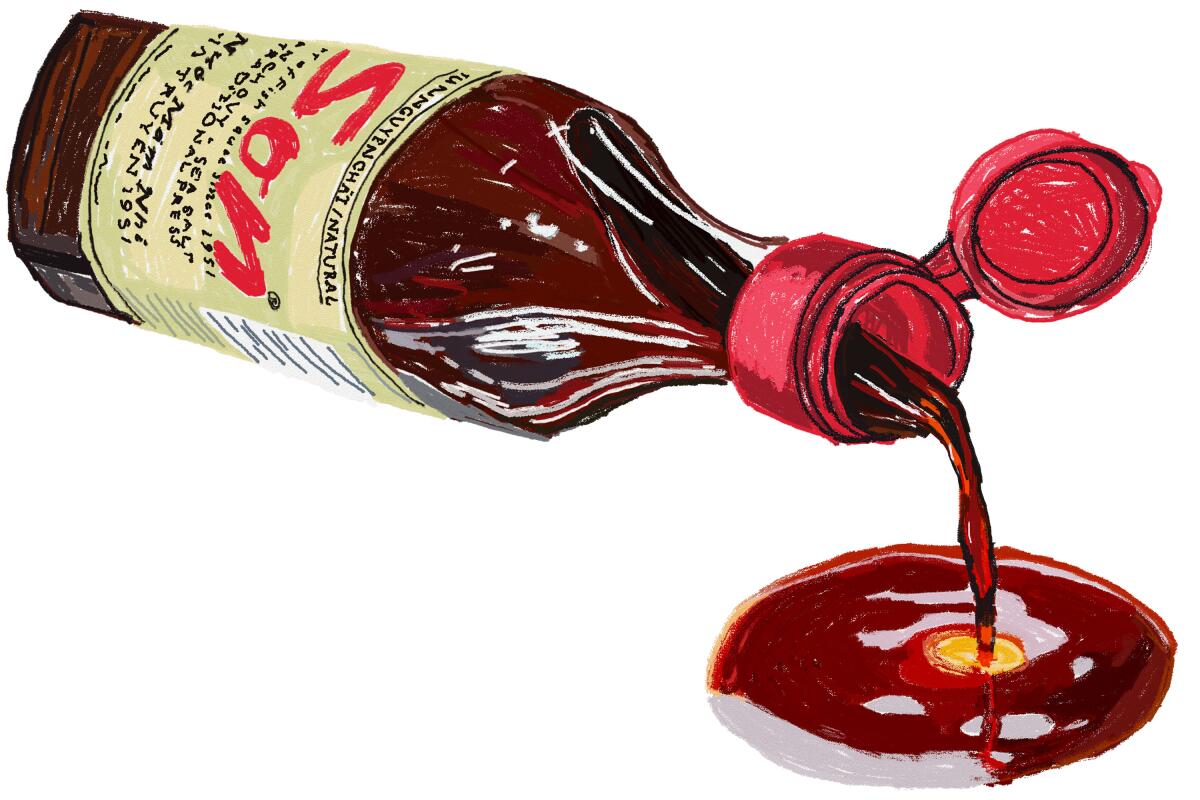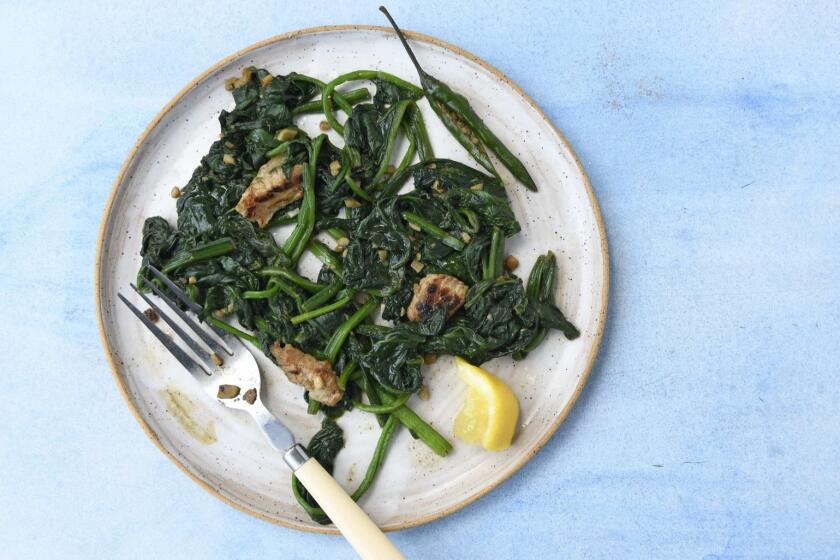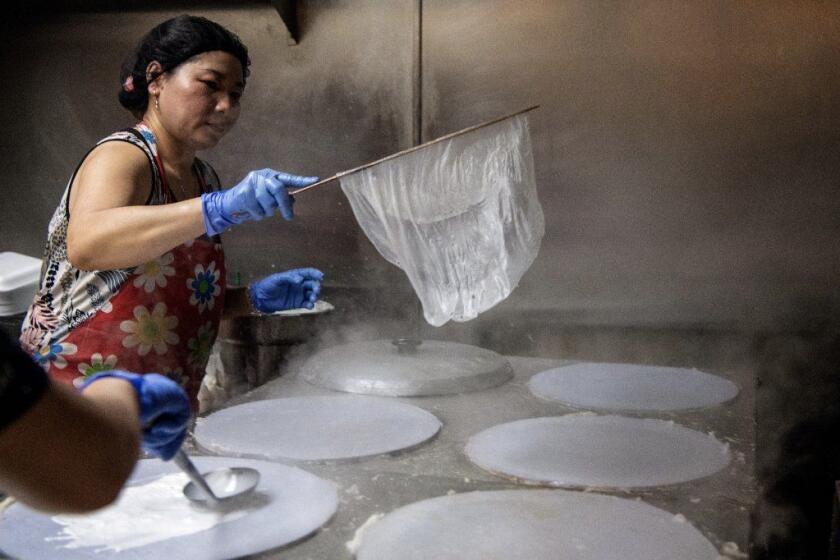From the motherland to the U.S., a Vietnamese fish sauce with umami oomph

- Share via
When my family escaped the communist takeover of Vietnam and settled in Southern California in 1975, we gained freedom but lost good fish sauce.
There wasn’t a trade agreement between the U.S. and Vietnam after the war ended, so, along with our compatriots, we were forced to depend on producers in Thailand, Hong Kong and the Philippines for our most important pantry staple. Their renditions of the umami-laden condiment were serviceable, but we pined for bona fide Viet nuoc mam (say “nook mahm”).
Thankfully, a sea change during the last 10 years, led by premium brands such as Red Boat, has brought more nuoc mam from the motherland to our shores. Nowadays, Little Saigon markets carry brands that go far beyond the usual suspects.
Within my collection (there are about a dozen at any given time), Son Fish Sauce is a favorite. Compared with other fish sauces, Son has a pure flavor that’s intensely savory, so much so that I use about 30% less than usual.
It’s great for defining Viet dipping sauces, as well as for injecting cross-cultural umami into bloody marys, Caesar salad dressing and guacamole. Son, produced on tiny Hon Son Island in the Gulf of Thailand, is a friendly MVP in my kitchen.
Unable to find the bottles at my regular Little Saigon grocery haunts for months, I asked owner Danny Tran for the lowdown. We’d emailed over the years and I assumed that he was the scion of Khon Van Pham (1921-2004), the legendary fish sauce maker mentioned on the company website, who pioneered the industry on Hon Son.
But when we met, Danny, 35, immediately introduced me to his 27-year-old wife, Albee, the person with true nuoc mam DNA. She is Pham’s great-granddaughter, the fourth generation to work in the fish sauce trade, and her willowy grace belies a steely determination.
Albee and Danny’s story is neither a refugee nor a diaspora narrative. They are young, hyper-entrepreneurial Vietnamese transnationals who move fluidly back and forth across the Pacific.
Fish sauce has crossed over from Vietnamese cuisine to use in all kinds of home and restaurant cooking, but it’s hardly the only fermented sea beast potion that Viet cooks love.
The couple met when Danny was visiting Vietnam (he was born there but grew up in Orange County), then married and settled in Saigon (a.k.a Ho Chi Minh City). In 2012, Danny sold Albee and a friend on the idea of opening the Cajun Cua (cua is crab in Vietnamese), a riff on Viet-Cajun restaurants like the Boiling Crab.
Launching and expanding their business was relatively easy, they said, but running it was harder. “After the second one, I wanted to kill him,” Albee joked.
Nevertheless, their success proved that importing ideas from America to the motherland was worthwhile. Why not go in the reverse direction? With quality fish sauce gaining traction among Western chefs, it seemed like the perfect time to export nuoc mam.
“My family did a lot of wholesale business to supply fish sauce to nearby Phu Quoc Island, so they never thought much about building their own brand,” Albee said. Danny saw the opportunity in a different light.
“Vietnamese people, we’ve been here [in America] for like 30, 40 years,” he said. “I would like us to have a product on the shelf that everybody can be proud of.”
He wanted Viet-American pride to extend beyond pho noodle soup and ao dai traditional tunic outfits.
With little experience in food product marketing and sales, they sold their stake in the restaurant and relocated to California in 2014 to launch Son Fish Sauce.
Independent and undaunted (they received no handouts from their families, Danny emphasized), the couple passed on using distributors. Danny regularly loaded his car with a pallet’s worth of fish sauce and delivered cases to Asian supermarkets. “It got scary if the boxes shifted too much on the road,” he recalled.
Fish sauce smells strong and the workhorse condiment is commonly combined with other ingredients to work its umami magic.
They hustled and did in-store events, driving as far as New Mexico and, if needed, staying at the market owner’s home. Many of the grocers were located in relatively low-income areas and served an international clientele. To Mexican customers, Danny suggested using fish sauce for boosting flavor in salsas and menudo; he sold Filipinos on using Son for Jollibee-style spaghetti. When he spotted Caribbean shoppers carrying fried whole fish, he pitched making a dipping sauce of jalapeños and fish sauce.
Albee, meanwhile, focused on converting Vietnamese customers. “Em la deh-mo lay-dee,” Albee said in charming Viet-glish, talking about her demos of fish sauce and cucumber slices. Initial response was mixed; customers had gotten used to the flavor of non-Viet fish sauce, and Son’s artisanal condiment seemed off.
Some said Albee’s nuoc mam wasn’t salty enough. Others noted the lack of bot ngot (monosodium glutamate) as a sign that Son wasn’t the real deal.
Detailing their old-fashioned method of using delicate-tasting anchovies, sea salt and 12 months of aging in wooden barrels didn’t always convince people of the purity of their first-press (think extra virgin olive oil) product. And some Viet people questioned if FDA inspection and approval really meant a clean, legit product.
Recounting the feedback, Albee revealed her geeky fish-sauce-maker self.
“The fish vary by season, so the fish sauce intensity differs,” she explained. Viet producers gauge a batch’s potency by the “N,” or grams of nitrogen per liter of fish sauce. The nitrogen level indicates a condiment’s umami oomph, which is based on amino acids (mostly glutamates) naturally released during the aging process. I liken the N numbers to octane levels in gasoline.
“We blend nuoc mam nhi (first-press fish sauce) from the best barrels to arrive at 40 or 41N. That’s perfect,” Albee said resolutely. “There’s no addition of any extra water.”
Everything you need to know about banh cuon, Vietnamese rice sheets
For the second pressing, they add salted water, ferment again, and blend for a 25N result. Though the same fish may be used up to seven times to make different grades of fish sauce, Son bottles only the first (40N) and second (25N) pressings.
Because her family has been on the isolated island for decades, they’ve had no desire or need to change their production process, Albee explained. The family owns barrel houses and fishing boats, plus they have generations of fish-sauce makers and even someone who does the lab work to test results.
Despite having a solid fish-sauce legacy, there have been ups and downs. Being young and inexperienced, they hesitated, made mistakes, and also got distracted, spending nine months in Mississippi to explore the dried-shrimp business, according to Danny. All this likely explains why Little Saigon’s Son supply was slack for a spell.
Where to buy Son Fish Sauce
Suddenly, a sparkle appeared in Danny’s eyes as he ticked off recent developments and plans. After five years of talk, he finally sent his first shipment to Charles Phan and the Slanted Door Group in San Francisco, and he hopes to expand to more restaurants. Markets in Little Saigon, Los Angeles, San Diego and the Bay Area have stock again. The couple is pushing hard for online sales to reach nontraditional fish sauce users. Albee reported that about 90 percent of their online sales are to non-Asians.
To refill my personal supply of Son, I went to Green Farm Market in Garden Grove. A clerk led me to the display near the store entrance and proclaimed in Vietnamese, “This is the finest.” An older woman nearby asked, “Is it good? I don’t want nuoc mam with MSG. Is it in there?”
Nope, but it’s thom ngon (fragrant and delicious) and dam da (has savory depth, umami), like quality old-fashioned nuoc mam, although it’s pricier than others. Was she ready for it? “Yes, I want good nuoc mam from Vietnam,” she said.
More to Read
Eat your way across L.A.
Get our weekly Tasting Notes newsletter for reviews, news and more.
You may occasionally receive promotional content from the Los Angeles Times.












